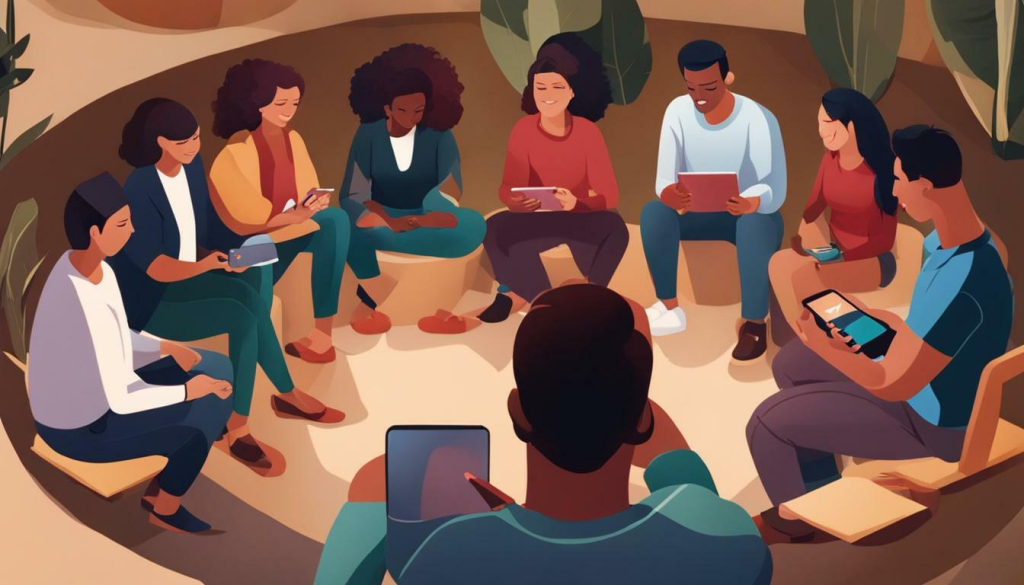Are you struggling with smartphone addiction and looking for ways to break free? Discover effective tips and strategies for smartphone addiction recovery.
Key Takeaways:
- Smartphone addiction is comparable to a process addiction, affecting the brain in similar ways to drugs.
- Recognizing the signs of addiction, such as compulsive phone use and an inability to reduce or stop phone use despite negative consequences, is crucial in addressing the issue.
- To break cell phone addiction, it is important to set concrete goals, seek support from family, friends, and professionals, and practice mindfulness.
- Strategies for moderating device use include setting limits, participating in phone-free days, using apps for monitoring and limiting phone time, and making changes to phone settings.
- Mindful scrolling, turning off notifications, and physically separating yourself from your phone can help in managing addictive behavior.
Unlocking your life from smartphone addiction can be a challenging task that requires intentional steps and coping skills. The rise of cell phone addiction has been fueled by the increasing use of smartphones for various daily tasks and interpersonal interactions.
Smartphone addiction is comparable to a process addiction, affecting the brain in similar ways to drugs. Recognizing the signs of addiction, such as compulsive phone use and an inability to reduce or stop phone use despite negative consequences, is crucial in addressing the issue.
By finding the right balance between smartphone use and other important aspects of life, it is possible to break free from smartphone addiction and regain control over your life.
Understanding Smartphone Addiction

Before diving into smartphone addiction recovery, it’s essential to understand the root causes and behavioral patterns associated with this modern-day addiction. The rise of cell phone addiction has been fueled by the increasing use of smartphones for various daily tasks and interpersonal interactions. Smartphone addiction is comparable to a process addiction, affecting the brain in similar ways to drugs.
Recognizing the signs of addiction, such as compulsive phone use and an inability to reduce or stop phone use despite negative consequences, is crucial in addressing the issue. Breaking cell phone addiction can be achieved through actions such as not using your phone as an alarm clock, setting limits for usage, turning your phone off for extended periods, practicing mindfulness, and seeking support from family, friends, and professionals.
Additionally, setting concrete goals to reduce smartphone use to a more manageable level is important. Various strategies can aid in moderating device use, such as setting aside one day a week to go phone-free, participating in a 30-day reset experiment, using apps to monitor and limit phone time, keeping the phone away from the bedroom, putting the phone away upon entering the home, and making changes to phone settings like disabling notifications.
Mindful scrolling, turning off notifications, and physically separating yourself from your phone can also help in managing addictive behavior. By finding the right balance between smartphone use and other important aspects of life, it is possible to break free from smartphone addiction and regain control over your life.
Understanding the factors contributing to smartphone addiction and implementing appropriate strategies are crucial steps in the recovery process. By taking these intentional steps and adopting coping skills, individuals can unlock their lives from smartphone addiction and reclaim their time and focus for other meaningful activities.
Recognizing the Signs of Smartphone Addiction

Identifying the signs of smartphone addiction is the first step towards breaking free from its grip. Learn how to recognize and acknowledge the extent of your phone dependence.
Smartphone addiction is a real and growing concern in today’s society. As technology continues to advance, we find ourselves increasingly reliant on our devices for various tasks and forms of entertainment. However, when our phone use becomes compulsive and starts affecting our daily lives, it may be a sign of addiction.
Some common signs of smartphone addiction include a constant need to check your phone, feeling anxious or restless when your phone is out of sight, neglecting other responsibilities or social interactions in favor of using your phone, and being unable to reduce or stop phone use despite negative consequences.
If you find yourself experiencing these symptoms, it is important to acknowledge that you may have a problem and take steps to address it.
Recognizing the signs of smartphone addiction is the first step towards breaking free from its grip.

Once you have identified the signs of smartphone addiction in your life, it is crucial to seek support and take proactive measures to overcome it. Start by gradually reducing your phone usage and setting limits for yourself. For example, designate specific times during the day when you will not use your phone, such as during mealtimes or before bed.
Practicing mindfulness can also be beneficial in managing smartphone addiction. Take moments throughout the day to be fully present and engaged in your surroundings, rather than constantly reaching for your phone. This can help break the cycle of compulsive phone checking and promote a healthier relationship with technology.
Remember, breaking free from smartphone addiction is a journey that requires patience and self-discipline. Surround yourself with a supportive network of friends, family, or professionals who can offer guidance and encouragement along the way. By taking these steps and implementing healthy habits, you can regain control over your life and forge a healthier relationship with your smartphone.
| Signs of Smartphone Addiction | Actions to Overcome Addiction |
|---|---|
| Constant need to check phone | Set limits for phone usage |
| Anxiety or restlessness without phone | Practice mindfulness and be present in the moment |
| Neglecting responsibilities for phone use | Seek support from friends, family, or professionals |
| Inability to reduce or stop phone use | Gradually reduce phone usage and set goals |
Taking the First Steps Towards Recovery

Embark on your journey to recovery by setting concrete goals and enlisting the support of loved ones or professional programs specifically designed for smartphone addiction. Breaking free from smartphone addiction is a process that requires commitment, self-awareness, and the willingness to make changes in your daily life.
One effective strategy is to start by not using your phone as an alarm clock. This simple step allows you to create distance between yourself and your device from the moment you wake up. Instead, invest in a traditional alarm clock or use a digital one that doesn’t have internet connectivity.
To further reduce your smartphone usage, consider setting limits on your phone usage. This can be done by scheduling specific times during the day when you will allow yourself to use your phone, and outside of those designated times, keeping your phone out of sight and reach. You can also turn your phone off for extended periods, such as during meal times or while engaging in activities that require your full attention.
Practicing mindfulness is another powerful tool for managing smartphone addiction. By being present in the moment and consciously aware of your phone use, you can begin to recognize triggers and patterns. Mindfulness techniques, such as deep breathing exercises or meditation, can help you regain control over impulsive urges to reach for your phone.
Additionally, seeking support from family, friends, or professionals who specialize in smartphone addiction recovery can provide invaluable guidance and accountability throughout your journey.
| Concrete Steps Towards Recovery |
|---|
| 1. Stop using your phone as an alarm clock |
| 2. Set limits for phone usage |
| 3. Turn your phone off for extended periods |
| 4. Practice mindfulness |
| 5. Seek support from loved ones or professionals |
Mindfulness Techniques for Managing Smartphone Use

Discover how mindfulness practices can help you develop a healthier relationship with your smartphone, allowing you to regain focus and presence in your daily life. In today’s digital age, it’s easy to get caught up in the constant notifications, endless scrolling, and addictive behaviors associated with smartphone use. However, by incorporating mindfulness techniques into your daily routine, you can break free from smartphone addiction and find balance.
One effective strategy is to practice mindful scrolling. Instead of mindlessly swiping through social media feeds or endlessly browsing the internet, take a moment to bring your attention to the present moment. Notice the sensations in your body, the thoughts and emotions that arise, and the impact that using your phone has on your mood. By developing this awareness, you can make more conscious choices about when and how you engage with your device.
Another helpful technique is to turn off notifications. Constant pings and alerts can be a major distraction and contribute to addictive phone use. By disabling unnecessary notifications and setting specific times to check your messages and emails, you can regain control over your attention and reduce the urge to constantly check your phone.
| Mindfulness Techniques for Managing Smartphone Use |
|---|
| Practice mindful scrolling |
| Turn off notifications |
| Physically separate yourself from your phone |
In addition, physically separating yourself from your phone can also help in managing addictive behavior. Designate specific phone-free areas or time periods throughout your day where you can focus on being fully present with yourself and others. This can include leaving your phone in another room while you work, socialize, or engage in activities that require your full attention.
By implementing these mindfulness techniques and making intentional choices about how and when you use your smartphone, you can develop a healthier relationship with technology.
Remember, breaking free from smartphone addiction is a journey that requires patience and self-compassion. Seek support from loved ones or professionals specializing in technology addiction treatment or internet addiction counseling to guide you along the way.
Utilizing Tools and Apps for Phone Control

Explore the range of technological solutions and online resources that can aid in your smartphone addiction recovery journey, providing support and assistance along the way.
When it comes to overcoming smartphone addiction, technology can actually be a powerful ally. With the rise of smartphone dependence, developers have recognized the need for tools and apps that can help individuals regain control over their device usage. These technological solutions can provide support, accountability, and guidance throughout the recovery process.
One of the key tools for managing smartphone addiction is the use of apps specifically designed to monitor and limit phone time. These apps allow you to track your usage patterns, set daily limits, and receive notifications when you’re nearing your preset limits.
They can also block access to certain apps or features for designated periods, helping you establish healthier habits and reduce the time spent mindlessly scrolling.
| App Name | Features |
|---|---|
| FocusMe | Block distracting apps and websites, schedule breaks, track time spent on phone |
| Moment | Track daily phone usage, set screen time limits, receive customizable reminders |
| Forest | Grow virtual trees by staying focused, track progress, earn rewards |
Another valuable resource for smartphone addiction recovery is online therapy. There are various platforms that offer counseling and support specifically tailored to phone addiction. These online therapy programs provide a convenient and accessible way to connect with licensed professionals who can help you address the root causes of your addiction and develop healthier coping strategies. With the ease of online sessions, you can receive the support you need from the comfort of your own home.
By utilizing these tools and resources, you can enhance your efforts towards smartphone addiction recovery. Remember, breaking free from addiction is a journey that requires commitment, support, and self-reflection. Embrace the technological solutions available to you, and take advantage of the online resources that can guide you along the way.
Creating a Healthy Environment for Smartphone Use

Learn how to create a nurturing environment that encourages mindful smartphone use and reduces the risk of falling back into addictive behaviors.
In the quest to break free from smartphone addiction, creating a healthy environment plays a crucial role. By implementing practical changes and habits, you can create a supportive space that promotes responsible smartphone use and reduces the chances of relapse into addictive behaviors.
Limiting Temptations
One effective strategy is to remove temptations that can trigger excessive phone use. Start by not using your phone as an alarm clock; instead, invest in a traditional alarm clock. Keeping your phone out of the bedroom can create a more peaceful sleeping environment and discourage the urge to reach for it first thing in the morning or during the night.
Make it a habit to put your phone away upon entering your home, reducing the temptation to mindlessly pick it up.
| Practical Tips: | Results: |
|---|---|
| Invest in a traditional alarm clock to eliminate the need for your phone in the bedroom. | A more peaceful sleeping environment and reduced temptation to reach for your phone. |
| Put your phone away upon entering your home to minimize mindless phone usage. | Reduced temptation to constantly check your phone and increased focus on other activities. |
Setting Boundaries and Priorities
Establishing clear boundaries and priorities is another essential step in creating a healthy smartphone environment. Set limits for your phone usage, such as designating specific times for checking messages or social media.
Consider participating in a 30-day reset experiment, where you minimize phone usage for a month to break free from habitual behaviors. By setting concrete goals to reduce smartphone use overall, you can regain control over your time and attention.
“By setting clear boundaries and priorities, you can create a healthier relationship with your smartphone and experience a greater sense of balance in your life.”
Utilizing Phone Settings
Take advantage of your phone’s settings to further manage addictive behaviors. Disable notifications or customize them to reduce distractions and interruptions.
Put your phone on silent mode or use the “do not disturb” feature during specific hours to create periods of uninterrupted focus. By physically separating yourself from your phone, whether by leaving it in another room or using phone-free zones, you can decrease the impulse to constantly check your device.
Creating a healthy environment for smartphone use is a powerful step towards breaking free from addiction. By implementing these strategies and finding the right balance between smartphone use and other aspects of life, you can foster a mindful approach to technology and regain control over your life.
The Power of Disconnecting: Mindful Scrolling and Notification Management

Discover how disconnecting from constant digital stimulation through mindful scrolling and notification management can significantly contribute to your smartphone addiction recovery.
Smartphones have become an integral part of our daily lives, often causing us to lose track of time and disconnect from the present moment. Mindful scrolling is a strategy that involves consciously and intentionally using your phone, rather than mindlessly scrolling through endless feeds and notifications.
By practicing mindful scrolling, you can control the amount of time you spend on your phone and avoid falling into addictive patterns of behavior.
One effective technique for mindful scrolling is to create a digital decluttering routine. Start by organizing your apps and removing any unnecessary ones that may contribute to distractions. Prioritize the apps that align with your goals and bring value to your life.
Consider using folders to group similar apps together, making it easier to navigate your phone and reduce the temptation to mindlessly jump between different apps.
Another important aspect of disconnecting is managing your notifications. Constant beeping, buzzing, and vibrating can easily lead to distraction and fuel addictive behavior. Take control of your notifications by turning off non-essential ones or setting specific times to check them. This way, you can limit interruptions and regain focus on the tasks at hand. Remember, you are in control of your phone, not the other way around.
| Benefits of Mindful Scrolling and Notification Management | Steps to Take |
|---|---|
| Reduced distractions and increased focus | Create a digital decluttering routine by organizing apps and removing unnecessary ones |
| Better time management and productivity | Turn off non-essential notifications or set specific times to check them |
| Improved mental well-being and reduced stress | Practice mindful scrolling by consciously using your phone and avoiding mindless scrolling |
Remember, breaking free from smartphone addiction is a journey that requires intentional steps. By implementing mindful scrolling and notification management techniques, you can regain control over your phone usage and prioritize your overall well-being. Stay present, stay mindful, and unlock a life free from smartphone addiction.
Conclusion
Breaking free from smartphone addiction is an ongoing process that requires commitment, support, and self-reflection. Take the first step towards reclaiming your life today and seek the necessary support to overcome smartphone addiction.
Unlocking your life from smartphone addiction can be a challenging task that requires intentional steps and coping skills. The rise of cell phone addiction has been fueled by the increasing use of smartphones for various daily tasks and interpersonal interactions. Smartphone addiction is comparable to a process addiction, affecting the brain in similar ways to drugs.
But by finding the right balance between smartphone use and other important aspects of life, it is possible to break free from smartphone addiction and regain control over your life.
Uncover the future of well-being and innovation! Explore our blog for captivating insights at the crossroads of health and technology. Your journey to a healthier, tech-enhanced life starts here.
FAQ
Q: What is smartphone addiction recovery?
A: Smartphone addiction recovery refers to the process of breaking free from excessive and compulsive phone use in order to regain control over one’s life and reduce the negative impacts of smartphone addiction.
Q: How can I understand smartphone addiction?
A: Understanding smartphone addiction involves recognizing the reasons behind the addiction and educating oneself on the behaviors and effects associated with excessive phone use.
Q: What are the signs of smartphone addiction?
A: Signs of smartphone addiction include compulsive phone use, an inability to reduce or stop phone use despite negative consequences, neglecting other responsibilities and relationships due to phone use, and experiencing withdrawal symptoms when the phone is not accessible.
Q: How do I take the first steps towards smartphone addiction recovery?
A: Taking the first steps towards recovery involves setting goals for reducing phone use, seeking support from loved ones or professionals, and being willing to make changes in your behavior and habits.
Q: What strategies can help me moderate my phone usage?
A: Strategies for phone moderation include not using your phone as an alarm clock, setting limits for usage, turning your phone off for extended periods, and participating in activities that do not involve phone use.
Q: How can mindfulness techniques help manage smartphone addiction?
A: Mindfulness techniques, such as practicing mindful scrolling and being present in the moment, can help individuals become more aware of their phone use and reduce compulsive behaviors associated with smartphone addiction.
Q: Are there any tools or apps available to control phone usage?
A: Yes, there are various tools and apps that can help monitor and limit phone time, block distracting apps, and provide reminders to take breaks from phone use.
Q: How can I create a healthy environment for smartphone use?
A: Creating a healthy environment involves setting boundaries, keeping the phone away from the bedroom, and making changes to phone settings, such as disabling notifications.
Q: What is mindful scrolling and how does it help manage smartphone addiction?
A: Mindful scrolling refers to being intentional and conscious while using social media or browsing the internet, avoiding mindless and excessive scrolling. This practice can help reduce addictive behaviors and promote a healthier relationship with your phone.
Q: What should I do if I need ongoing support for smartphone addiction recovery?
A: Seeking ongoing support from professionals, support groups, or loved ones is vital for long-term recovery from smartphone addiction. There are various resources available for individuals seeking support and guidance in their journey towards breaking free from smartphone addiction.



